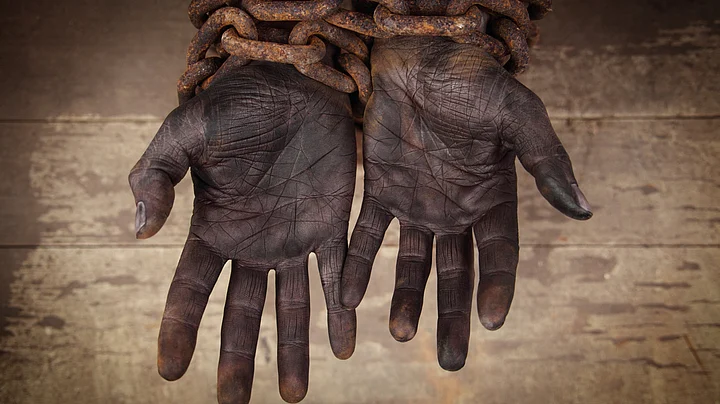It is a widely held belief that slavery has been long abolished and buried. Something so inhuman and barbaric can hardly be allowed to co-exist with the exalted institutions of democracy. The popular concept that slaves are kept in metal chains is naive.
The hidden slaves sweating for our luxury and progress are bound by unseen chains of poverty, ignorance, awareness, manipulation and exploitation. Modern slavery or neo-slavery is all around us, but most of us prefer to look the other way, because it benefits all moneyed classes in some way or the other.
Maybe we need to change the definition of slavery. People might be slaves in hidden ways and in different quanta. Throughout history, slavery has meant a loss of free will and choice backed up by punitive control exercised by the slaveholder, or by elements of the state.
Control in the Hands of Modern Power Centres
Control has now passed on indirectly into the hands of various modern power centres. Slavery has moved into the many shades of grey. People no longer need to be sold or bought into slavery. They are manipulated through monetary and psychological tools to be used as cogs in capitalist machinery in which they have no stakes.
BR Ambedkar said about the Preamble to the Constitution of India:
“Liberty, equality and fraternity are principles of life which cannot be divorced from each other. Liberty cannot be divorced from equality; equality cannot be divorced from liberty. Nor can liberty and equality be divorced from fraternity. Without equality, liberty would produce the supremacy of the few over the many.”
The bonded labour tradition in India found its genesis in the centuries-old warped social hierarchy and caste system. Landed zamindars, money lenders and people from the self-styled higher classes exploited the deprived and distressed castes and sections by giving them nominal wages for labour which was barely enough to keep body and soul together.
This trapped them in a deep rut of self-perpetuating debt, reducing them to be chattel or bandhwa mazdoor (bonded labour).
In 1976, we patted ourselves on the back for promulgating an Act to abolish bonded labour. But did we really succeed in bringing around the promised equality, freedom, and fraternity to all?
What kind of freedom does the marginalised population of India enjoy? Workers at the bottom of the economic ladder have few options to begin with, but at some point even those options are snatched away.
During the present lockdown, the migrant workers could not exercise their choice to go home. Forced to migrate hundreds and thousands of miles from their homes in search of a subsistence-level income, they found themselves on the road overnight. In spite of toiling for a living away from their families and homes, they are not able to afford a roof over their head or savings to see them through such eventualities.
Subalterns of society continue to be slaves through poverty, lack of education and awareness. Any rights that the law gives them are futile if they are not made aware of them.
Deprivation is the invisible chain that keeps people tethered to the daily grind of finding the next meal. Where is the time to think beyond it? Lack of quality education robs the worker class of a voice. It is a huge challenge for an uneducated person to keep pace with this highly technical and volatile world, let alone raise a voice for personal rights.
Genders Disparities and Exploitation
Gender disparities and exploitation is another face of continuing slavery. A large number of women are forced into underage marriages or trapped in abusive, unhappy marriages. They are held captive through social pressure, financial dependence, threats and responsibility towards their children.
Most of them have been brought up with absolute lack of confidence in taking bold decisions. Those who may want to take a decision in breaking away, find no adequate social security or government support to do so. Many go through a lifetime of working as household chattel and tolerating abuse.
Human trafficking in India is huge. There are no reliable numbers available for the trafficked people, but an approximation by reports of NGOs peg the number at 65 million. Traffickers often lure young villagers and children with the promise of work in cities. They are further sold into brothels, married to much older men, forced into bonded labour in mining or agricultural sectors or used as unpaid household maids. Transgender communities are another group of people trapped and exploited for centuries for being born into bodies which do not fit the deemed normal.
The promise made to every Indian citizen in the Constitution must be honoured. No one was born a slave. No one was born to slave another. The new world system finds no place for hidden slavery. It will catch up with the exploiters eventually.
(Dr Ranjit Powar is a former civil services officer with the Punjab Civil Services. She is a Ph.D. in Psychology. She is the founder of the NGO ‘Nishan Educational Trust’. Her first book, “Dusk Over Mustard Fields” is under publication. This is an opinion piece, and the views expressed are the author’s own. The Quint neither endorses nor is responsible for them.)
(At The Quint, we question everything. Play an active role in shaping our journalism by becoming a member today.)
